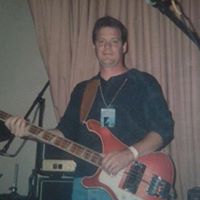Richard R Ruby
age ~33
from Ventura, CA
- Also known as:
-
- Dick R Ruby
- Rick R Ruby
- Phone and address:
- 1300 Saratoga Ave UNIT 101, Ventura, CA 93003
Richard Ruby Phones & Addresses
- 1300 Saratoga Ave UNIT 101, Ventura, CA 93003
- Long Beach, CA
Name / Title
Company / Classification
Phones & Addresses
President
Jewish Family and Childrens Service of Long Beach/West Orange County
Individual/Family Services
Individual/Family Services
3801 E Willow St, Long Beach, CA 90815
5624277916
5624277916
President
Rumac Sg Corporation
5554 Market Pl, Cypress, CA 90630
President
OUTSTANDING RESTAURANTS, INC
5554 Market Pl, Cypress, CA 90630
RAR LLC
SWEET ADDICTION, LTD
Manager
Cedar Corporation
Fast-Food Rest Chain
Fast-Food Rest Chain
11755 Whittier Blvd, Whittier, CA 90601
7149523821
7149523821
Us Patents
-
Microcap Wafer-Level Package
view source -
US Patent:6376280, Apr 23, 2002
-
Filed:Oct 8, 1999
-
Appl. No.:09/415284
-
Inventors:Richard C. Ruby - Menlo Park CA
Tracy E. Bell - Campbell CA
Frank S. Geefay - Cupertino CA
Yogesh M. Desai - San Jose CA -
Assignee:Agilent Technologies, Inc. - Palo Alto CA
-
International Classification:H01L 2144
-
US Classification:438118, 438110, 438455, 438612
-
Abstract:A microcap wafer-level package is provided in which a micro device is connected to bonding pads on a base wafer. A peripheral pad on the base wafer encompasses the bonding pads and the micro device. A cap wafer has gaskets formed thereon using a thick photoresist semiconductor photolithographic process. Bonding pad gaskets match the perimeters of the bonding pads and a peripheral pad gasket matches the peripheral pad on the base wafer. Wells are located inside the perimeters of the bond pad gaskets and are formed to a predetermined depth in the cap wafer. The cap wafer is then placed over the base wafer to cold weld bond the gaskets to the pads and form a hermetically sealed volume between the bonding pad gaskets and the peripheral pad gasket. The cap wafer is then thinned below the predetermined depth until the wells become through holes that provide access to the bonding pads inside the package, but outside the hermetically sealed volume, for connecting wires from a micro device utilizing system.
-
Acoustic Resonator Filter With Reduced Electromagnetic Influence Due To Die Substrate Thickness
view source -
US Patent:6377137, Apr 23, 2002
-
Filed:Sep 11, 2000
-
Appl. No.:09/659254
-
Inventors:Richard C. Ruby - Menlo Park CA
-
Assignee:Agilent Technologies, Inc. - Palo Alto CA
-
International Classification:H03H 954
-
US Classification:333189, 333187, 310321, 310324, 310348, 29 2535, 438959
-
Abstract:A plurality of acoustic resonators are manufactured in a batch process by forming cavities in a substrate and filling the cavities with a sacrificial layer. An FBAR membrane comprising a bottom electrode, a piezoelectric layer, and a top electrode is formed over each cavity and the sacrificial layer. The substrate is then thinned and the substrate is separated into a plurality of dice using a scribe and break process. The sacrificial layer is then removed and the FBAR filter is mounted in a package with thermal vias being thermal communication with underside of the FBAR filter. The production method improves thermal properties by increasing the efficiency of heat dissipation from the FBAR filter. In addition, electromagnetic interference is decreased by reducing the distance between a primary current flowing over the surface of the FBAR filter and an image current flowing in a ground plane beneath the FBAR filter.
-
Cavity Spanning Bottom Electrode Of A Substrate-Mounted Bulk Wave Acoustic Resonator
view source -
US Patent:6384697, May 7, 2002
-
Filed:May 8, 2000
-
Appl. No.:09/566868
-
Inventors:Richard C. Ruby - Menlo Park CA
-
Assignee:Agilent Technologies, Inc. - Palo Alto CA
-
International Classification:H03H 900
-
US Classification:333189, 333187
-
Abstract:A filter formed of acoustic resonators, where each resonator has its own cavity and a bottom electrode that spans the entirety of the cavity, so that the bottom electrode has an unsupported interior region surrounded by supported peripheral regions. In the preferred embodiment, the cavity is formed by etching a depression into the substrate, filling the depression with a sacrificial material, depositing the piezoelectric and electrode layers that define an FBAR or SBAR, and then removing the sacrificial material from the depression. Also in the preferred embodiment, the sacrificial material is removed via release holes that are limited to the periphery of the depression. Preferably, the bottom electrode is the only electrode that spans the cavity, thereby limiting the formation of parasitic FBARs or SBARs. In one embodiment, the bottom electrode includes a serpentine edge that leaves a portion of one side of the cavity free of overlap by the bottom electrode, so that a top electrode may overlap this portion. Thus, the top and bottom electrodes can overlap the same side without sandwiching the piezoelectric layer outside of the unsupported interior region.
-
Bulk Acoustic Resonator Perimeter Reflection System
view source -
US Patent:6424237, Jul 23, 2002
-
Filed:Dec 21, 2000
-
Appl. No.:09/746525
-
Inventors:Richard C. Ruby - Menlo Park CA
Paul D. Bradley - Mountian View CA -
Assignee:Agilent Technologies, Inc. - Palo Alto CA
-
International Classification:H03H 915
-
US Classification:333187, 333191, 310324, 310365, 310349, 29 2535
-
Abstract:A bulk acoustic resonator having a high quality factor is formed on a substrate having a depression formed in a top surface of the substrate. The resonator includes a first electrode, a piezoelectric material and a second electrode. The first electrode is disposed on the top surface of the substrate and extends beyond the edges of the depression by a first distance to define a first region therebetween. The piezoelectric material is disposed on the top surface of the substrate and over the first electrode, and the second electrode is disposed on the piezoelectric material. The second electrode includes a portion that is located above the depression. The portion of the second electrode that is located over the depression has at least one edge that is offset from a corresponding edge of the depression by a second distance to define a second region therebetween. The first and second regions have different impedances, as a result of the different materials located in the two regions. In addition, the first and second distances are approximately equal to a quarter-wavelength of a sound wave travelling laterally across the respective region, such that reflections off of the edges of the regions constructively interfere to maximize the reflectivity of the resonator.
-
Microcap Wafer-Level Package
view source -
US Patent:6429511, Aug 6, 2002
-
Filed:Oct 1, 2001
-
Appl. No.:09/969432
-
Inventors:Richard C. Ruby - Menlo Park CA
Tracy E. Bell - Campbell CA
Frank S. Geefay - Cupertino CA
Yogesh M. Desai - San Jose CA -
Assignee:Agilent Technologies, Inc. - Palo Alto CA
-
International Classification:H01L 2348
-
US Classification:257704, 257685, 257686, 257723, 257777
-
Abstract:A microcap wafer-level package is provided in which a micro device is connected to bonding pads on a base wafer. A peripheral pad on the base wafer encompasses the bonding pads and the micro device. A cap wafer has gaskets formed thereon using a thick photoresist semiconductor photolithographic process. Bonding pad gaskets match the perimeters of the bonding pads and a peripheral pad gasket matches the peripheral pad on the base wafer. Wells are located inside the perimeters of the bond pad gaskets and are formed to a predetermined depth in the cap wafer. The cap wafer is then placed over the base wafer to cold weld bond the gaskets to the pads and form a hermetically sealed volume between the bonding pad gaskets and the peripheral pad gasket. The cap wafer is then thinned below the predetermined depth until the wells become through holes that provide access to the bonding pads inside the package, but outside the hermetically sealed volume, for connecting wires from a micro device utilizing system.
-
Passband Filter Having An Asymmetrical Filter Response
view source -
US Patent:6462631, Oct 8, 2002
-
Filed:Feb 14, 2001
-
Appl. No.:09/783773
-
Inventors:Paul Bradley - Mountain View CA
Richard C. Ruby - Menlo Park CA -
Assignee:Agilent Technologies, Inc. - Palo Alto CA
-
International Classification:H03H 958
-
US Classification:333189, 333187
-
Abstract:A filter, such as a transmit filter of a duplexer, includes an array of acoustic resonators that cooperate to establish an asymmetrically shaped filter response over a target frequency passband. The acoustic resonators are preferably film bulk acoustic resonators (FBARs). The filter response defines an insertion loss profile in which a minimum insertion loss within the target passband is located at or near a first end of the frequency passband, while the maximum insertion loss is located at or near the opposite end of the frequency passband. In the transmit filter embodiment, the minimum insertion loss is at or near the high frequency end of the filter response, which is tailored by selectively locating poles and zeros of the array of FBARs.
-
Method Of Mass Loading Of Thin Film Bulk Acoustic Resonators (Fbar) For Creating Resonators Of Different Frequencies And Apparatus Embodying The Method
view source -
US Patent:6469597, Oct 22, 2002
-
Filed:Mar 5, 2001
-
Appl. No.:09/799204
-
Inventors:Richard C. Ruby - Menlo Park CA
Paul D. Bradley - Mountain View CA -
Assignee:Agilent Technologies, Inc. - Palo Alto CA
-
International Classification:H03H 956
-
US Classification:333187, 333188, 333191, 310312, 29 2535
-
Abstract:A method for fabricating a resonator, and in particular, a thin film bulk acoustic resonator (FBAR), and a resonator embodying the method are disclosed. An FBAR is fabricated on a substrate by introducing a mass loading electrode to a bottom electrode layer. For a substrate having multiple resonators, mass loading bottom electrode is introduced for only selected resonator to provide resonators having different resonance frequencies on the same substrate.
-
Controlled Effective Coupling Coefficients For Film Bulk Acoustic Resonators
view source -
US Patent:6472954, Oct 29, 2002
-
Filed:Apr 23, 2001
-
Appl. No.:09/841234
-
Inventors:Richard C. Ruby - Menlo Park CA
Paul Bradley - Mountain View CA
Domingo Figueredo - Livermore CA
Yury Oshmyansky - Camarillo CA -
Assignee:Agilent Technologies, Inc. - Palo Alto CA
-
International Classification:H03H 9205
-
US Classification:333133, 333188, 29 2535, 310312, 310364
-
Abstract:In an array of acoustic resonators, the effective coupling coefficient of first and second filters are individually tailored in order to achieve desired frequency responses. In a duplexer embodiment, the effective coupling coefficient of a transmit band-pass filter is lower than the effective coupling coefficient of a receive band-pass filter of the same duplexer. In one embodiment, the tailoring of the coefficients is achieved by varying the ratio of the thickness of a piezoelectric layer to the total thickness of electrode layers. For example, the total thickness of the electrode layers of the transmit filter may be in the range of 1. 2 to 2. 8 times the total thickness of the electrode layers of the receive filter. In another embodiment, the coefficient tailoring is achieved by forming a capacitor in parallel with an acoustic resonator within the filter for which the effective coupling coefficient is to be degraded. Preferably, the capacitor is formed of the same materials used to fabricate a film bulk acoustic resonator (FBAR).
Resumes

Directof Of Technology (Fbar & Orthogonal Markets) At Avago Technologies
view sourceLocation:
San Francisco Bay Area
Industry:
Semiconductors

Richard Ruby
view sourceLocation:
United States

Mcdonald's Owner/Operator
view sourceLocation:
Orange County, California Area
Industry:
Restaurants

Richard Ruby
view source
Richard Ruby
view source
Richard Baxter Ruby
view source
Richard Ruby
view source
Richard Ruby III
view source
Richard Ruby
view source
Richard Ruby
view source
Richard Ruby
view sourceNews

6 Chinese nationals charged with stealing US trade secrets
view source- Richard Ruby, Pang's former boss at Avago attended a conference in China in late 2001 and toured the new Tianjin lab created by the defendants, according to the indictment. During that tour, Ruby recognized technology stolen from Avago and confronted Wei Pang and Jingpin Chen, a college dean.
- Date: May 19, 2015
- Category: U.S.
- Source: Google
Classmates

Richard Ruby
view sourceSchools:
Magnolia Avenue Elementary School Los Angeles CA 1943-1947
Community:
Sharry Downing, Mary Romero, Victor Dominguez, Giselle Rosa

Richard Ruby
view sourceSchools:
Magnolia Avenue Elementary School Los Angeles CA 1944-1947, Berendo Junior High School Los Angeles CA 1947-1950
Community:
Sheila Whitney, Benny Esparza, Charmagne Wilson

Richard Ruby
view sourceSchools:
Rock Falls High School Rock Falls IL 1958-1962
Community:
Les Lawrence, Theresa Vickers, Donna Harrell, Diane Debord, James Brandt, Anna Ordean, William Abell, Rose Thompson, Charles Sprague, Betty Smith, Nancy Musser, Nadine Long

Richard Ruby
view sourceSchools:
Evening Shade High School Evening Shade AR 1979-1980, Pleasant Hill High School Pleasant Hill MO 1982-1986
Community:
Marlene Williams, Charlene Hudspeth, Randy Wright

Richard Ruby, Principia H...
view source
Richard Ruby, Safford Hig...
view source
Ruby Richard, Judice High...
view source
Principia High School, St...
view sourceGraduates:
Gabriel Mondino (1977-1981),
Richard Ruby (1947-1951),
Todd Beck (1983-1987),
Maryanne Murdock (1962-1966)
Richard Ruby (1947-1951),
Todd Beck (1983-1987),
Maryanne Murdock (1962-1966)
Myspace
Youtube
Googleplus

Richard Ruby
Flickr
Get Report for Richard R Ruby from Ventura, CA, age ~33

















